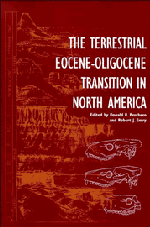Book contents
- Frontmatter
- Contents
- Contributors
- Preface
- PART I The Chronostratigraphy of the Uintan through Arikareean
- PART II Common Vertebrates of the White River Chronofauna
- 16 Testudines
- 17 Squamata
- 18 Ischyromyidae
- 19 Cylindrodontidae
- 20 Castoridae
- 21 Canidae
- 22 Nimravidae
- 23 Amphicyonidae
- 24 Small Arctoid and Feliform Camivorans
- 25 Merycoidodontinae and Miniochoerinae
- 26 Leptaucheniinae
- 27 Leptomerycidae
- 28 Camelidae
- 29 Hyracodontidae
- Summary
- Index
23 - Amphicyonidae
Published online by Cambridge University Press: 06 July 2010
- Frontmatter
- Contents
- Contributors
- Preface
- PART I The Chronostratigraphy of the Uintan through Arikareean
- PART II Common Vertebrates of the White River Chronofauna
- 16 Testudines
- 17 Squamata
- 18 Ischyromyidae
- 19 Cylindrodontidae
- 20 Castoridae
- 21 Canidae
- 22 Nimravidae
- 23 Amphicyonidae
- 24 Small Arctoid and Feliform Camivorans
- 25 Merycoidodontinae and Miniochoerinae
- 26 Leptaucheniinae
- 27 Leptomerycidae
- 28 Camelidae
- 29 Hyracodontidae
- Summary
- Index
Summary
ABSTRACT
Beardogs (Mammalia, Amphicyonidae) are mid-Cenozoic arctoid carnivorans ranging in size from less than 5 to over 200 kg found as fossils on the northern continents and Africa. The earliest North American species are generally small animals of late Eocene and Oligocene age, placed in the genera Daphoenus, Daphoenictis, Paradaphoenus, and Brachyrhynchocyon. The most complete skeletons of these carnivorans come from the White River beds of the North American mid-continent, but more fragmentary remains found throughout the United States and southern Canada indicate that the family was widely dispersed in North America at the time of the Eocene-Oligocene transition.
INTRODUCTION
Amphicyonid carnivorans at the time of the Eocene-Oligocene transition are the oldest known representatives of the family, poised at the threshhold of a Holarctic radiation of marked diversity centered in the Oligocene and Miocene epochs. Amphicyonids, commonly known as “beardogs,” are the large carnivorans of the mid-Cenozoic that, together with the hemicyonine ursids, dominate the carnivore faunas of the northern continents in the Miocene. By the beginning of the Pliocene the amphicyonid-hemicyonine ursid interval has ended, and the dominant large terrestrial carnivores belong to the modern groups familiar to us today, the felids, ursine ursids, and canids.
Although the earliest amphicyonids are found in the late Eocene of both Eurasia and North America, the fossil record is predominantly North American and European. The oldest European (Cynodictis) and North American (Daphoenus) amphicyonids share a derived basicranial anatomy that proclaims a not-too-distant common ancestry in the Eocene.
- Type
- Chapter
- Information
- The Terrestrial Eocene-Oligocene Transition in North America , pp. 476 - 485Publisher: Cambridge University PressPrint publication year: 1996
- 11
- Cited by



